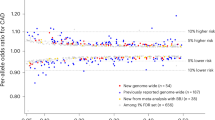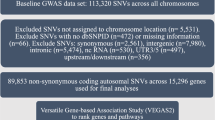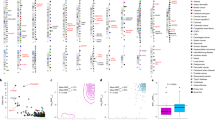Abstract
Coronary artery disease (CAD) causes more than 700,000 deaths each year in China. Previous genome-wide association studies (GWAS) in populations of European ancestry identified several genetic loci for CAD, but no such study has yet been reported in the Chinese population. Here we report a three-stage GWAS in the Chinese Han population. We identified a new association between rs6903956 in a putative gene denoted as C6orf105 on chromosome 6p24.1 and CAD (P = 5.00 × 10−3, stage 2 validation; P = 3.00 × 10−3, P = 1.19 × 10−8 and P = 4.00 × 10−3 in three independent stage 3 replication populations; P = 4.87 × 10−12, odds ratio = 1.51 in the combined population). The minor risk allele A of rs6903956 is associated with decreased C6orf105 mRNA expression. We report the first GWAS for CAD in the Chinese Han population and identify a SNP, rs6903956, in C6orf105 associated with susceptibility to CAD in this population.
This is a preview of subscription content, access via your institution
Access options
Subscribe to this journal
Receive 12 print issues and online access
$209.00 per year
only $17.42 per issue
Buy this article
- Purchase on Springer Link
- Instant access to full article PDF
Prices may be subject to local taxes which are calculated during checkout

Similar content being viewed by others
References
Lopez, A.D., Mathers, C.D., Ezzati, M., Jamison, D.T. & Murray, C.J. Global and regional burden of disease and risk factors, 2001: systematic analysis of population health data. Lancet 367, 1747–1757 (2006).
Sing, C.F., Stengard, J.H. & Kardia, S.L. Genes, environment, and cardiovascular disease. Arterioscler. Thromb. Vasc. Biol. 23, 1190–1196 (2003).
Wang, Q. Molecular genetics of coronary artery disease. Curr. Opin. Cardiol. 20, 182–188 (2005).
Broeckel, U. et al. A comprehensive linkage analysis for myocardial infarction and its related risk factors. Nat. Genet. 30, 210–214 (2002).
Wilson, P.W. et al. Prediction of coronary heart disease using risk factor categories. Circulation 97, 1837–1847 (1998).
Khot, U.N. et al. Prevalence of conventional risk factors in patients with coronary heart disease. J. Am. Med. Assoc. 290, 898–904 (2003).
Gibbons, G.H. et al. Genetic markers: progress and potential for cardiovascular disease. Circulation 109, IV47–IV58 (2004).
Marenberg, M.E., Risch, N., Berkman, L.F., Floderus, B. & de Faire, U. Genetic susceptibility to death from coronary heart disease in a study of twins. N. Engl. J. Med. 330, 1041–1046 (1994).
Wilson, P. Established risk factors and coronary artery disease: the Framingham Study. Am. J. Hypertens. 7, 7S–12S (1994).
Hirschhorn, J.N. & Daly, M.J. Genome-wide association studies for common diseases and complex traits. Nat. Rev. Genet. 6, 95–108 (2005).
McPherson, R. et al. A common allele on chromosome 9 associated with coronary heart disease. Science 316, 1488 (2007).
Samani, N.J. et al. Genomewide association analysis of coronary artery disease. N. Engl. J. Med. 357, 443 (2007).
Willer, C.J. et al. Newly identified loci that influence lipid concentrations and risk of coronary artery disease. Nat. Genet. 40, 161–169 (2008).
Wellcome Trust Case Control Consortium. Genome-wide association study of 14,000 cases of seven common diseases and 3,000 shared controls. Nature 447, 661–678 (2007).
Trégouët, D.A. et al. Genome-wide haplotype association study identifies the SLC22A3-LPAL2-LPA gene cluster as a risk locus for coronary artery disease. Nat. Genet. 41, 283–285 (2009).
Myocardial Infarction Genetics Consortium. et al. Genome-wide association of early-onset myocardial infarction with single nucleotide polymorphisms and copy number variants. Nat. Genet. 41, 334–341 (2009).
Helgadottir, A. et al. The same sequence variant on 9p21 associates with myocardial infarction, abdominal aortic aneurysm and intracranial aneurysm. Nat. Genet. 40, 217–224 (2008).
Gudbjartsson, D.F. et al. Sequence variants affecting eosinophil numbers associate with asthma and myocardial infarction. Nat. Genet. 41, 342–347 (2009).
Shen, G.Q. et al. Four SNPs on chromosome 9p21 in a South Korean population implicate a genetic locus that confers high cross-race risk for development of coronary artery disease. Arterioscler. Thromb. Vasc. Biol. 28, 360–365 (2008).
Schunkert, H. et al. Repeated replication and a prospective meta-analysis of the association between chromosome 9p21. 3 and coronary artery disease. Circulation 117, 1675–1684 (2008).
Assimes, T.L. et al. Susceptibility locus for clinical and subclinical coronary artery disease at chromosome 9p21 in the multi-ethnic ADVANCE study. Hum. Mol. Genet. 17, 2320–2328 (2008).
Zhou, L. et al. Associations between single nucleotide polymorphisms on chromosome 9p21 and risk of coronary heart disease in Chinese Han population. Arterioscler. Thromb. Vasc. Biol. 28, 2085–2089 (2008).
Seo, J., Kim, J. & Kim, M. Cloning of androgen-inducible gene 1 (AIG1) from human dermal papilla cells. Mol. Cells 11, 35–40 (2001).
Hanke, H., Lenz, C., Hess, B., Spindler, K.D. & Weidemann, W. Effect of testosterone on plaque development and androgen receptor expression in the arterial vessel wall. Circulation 103, 1382–1385 (2001).
Wu, F.C. & von Eckardstein, A. Androgens and coronary artery disease. Endocr. Rev. 24, 183–217 (2003).
Shen, G.Q. et al. An LRP8 variant is associated with familial and premature coronary artery disease and myocardial infarction. Am. J. Hum. Genet. 81, 780–791 (2007).
Zhang, X. et al. Mutation in nuclear pore component NUP155 leads to atrial fibrillation and early sudden cardiac death. Cell 135, 1017–1027 (2008).
Bustin, S.A. et al. The MIQE guidelines: minimum information for publication of quantitative real-time PCR experiments. Clin. Chem. 55, 611–622 (2009).
Acknowledgements
We thank the study subjects for their participation in and support of this project. We greatly appreciate the generous help from L. Li, G.Q. Shen, Y.J. Qian, F. Xu, F.C. Sun, F.S. Ji, B. Liu, X.Y. Zhou, Y. Xiao, S. Rao and B. Yang. This study was supported by China National 863 Scientific Program (2006AA02Z476), the China National Basic Research Program (973 program 2007CB512002), a Hubei Province Natural Science Key Program (2008CDA047), a Key Academic Program Leader Award of Wuhan City (200951830560), the National Natural Science Foundation of China (30670857, 30800457 and 81070106) and in part by the Center for Cardiovascular Genetics, Department of Molecular Cardiology, Lerner Research Institute, Cleveland Clinic.
Author information
Authors and Affiliations
Contributions
Study concept and design: Q.K.W., J.-P.C., X.T., Q.H. and M.-G.L.
Acquisition of data: C.-Q.X., Q.H., J.-P.C., X.-C.L., D.W., X.X., Y.-H.L., Q.-T.Z., X.C., Y.-Z.Y., C.L., R.Y., C.-C.W., G.W., Q.-L.L., Y.B., Y.-F.H., D.Y., Q.Y., X.-J.W., D.-P.D., R.-F.Z., J.W., J.-H.R., S.-S.L., Y.-Y.Z., F.-F.F., Y.H., Q.-X.L., S.-W.S., N.L., Z.-W.P., Y.L., B.Y., Y.-X.W., Y.-H.K., J.L., N.W., C.-Y.L., L.-Y.J., L.-J.G., L.L., H. Liu, E.-W.H., J.C., N.J., X.R., H. Li, T.K., X.-Q.Z., J.-Y.L., H.X., B.Y., L.-S.S. and Y.-L.X.
Analysis and interpretation of data: C.-Q.X., F.W., D.-P.D., J.-P.C., L.-S.S., X.-C.L., D.W., X.X., Q.H., X.T. and Q.K.W.
Drafting of the manuscript: C.-Q.X., F.W. and X.T.
Critical revision of the manuscript: Q.K.W., F.W. and C.-Q.X.
Statistical analysis: F.W. and C.-Q.X.
Study supervision: Q.K.W., Q.H., J.-P.C., X.T., Y.-H.L. and Y.-Z.Y.
Corresponding authors
Ethics declarations
Competing interests
The authors declare no competing financial interests.
Supplementary information
Supplementary Text and Figures
Supplementary Figures 1–4 and Supplementary Tables 1–4. (PDF 709 kb)
Rights and permissions
About this article
Cite this article
Wang, F., Xu, CQ., He, Q. et al. Genome-wide association identifies a susceptibility locus for coronary artery disease in the Chinese Han population. Nat Genet 43, 345–349 (2011). https://doi.org/10.1038/ng.783
Received:
Accepted:
Published:
Issue Date:
DOI: https://doi.org/10.1038/ng.783
This article is cited by
-
Rare and common coding variants in lipid metabolism-related genes and their association with coronary artery disease
BMC Cardiovascular Disorders (2024)
-
AGGF1 therapy inhibits thoracic aortic aneurysms by enhancing integrin α7-mediated inhibition of TGF-β1 maturation and ERK1/2 signaling
Nature Communications (2023)
-
Adtrp regulates thermogenic activity of adipose tissue via mediating the secretion of S100b
Cellular and Molecular Life Sciences (2022)
-
Association of lipid metabolism-related gene promoter methylation with risk of coronary artery disease
Molecular Biology Reports (2022)
-
Analysis for interaction between interleukin-35 genes polymorphisms and risk factors on susceptibility to coronary heart disease in the Chinese Han population
BMC Cardiovascular Disorders (2021)



